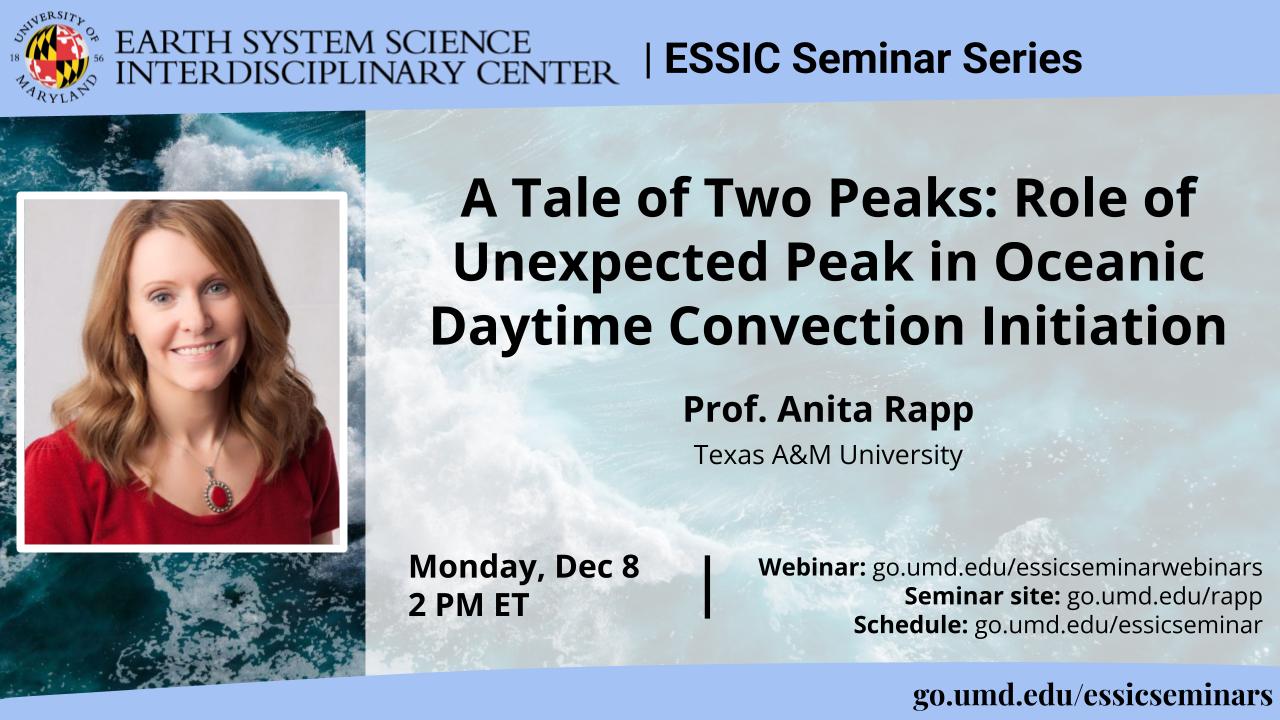
A Tale of Two Peaks: Role of Unexpected Peak in Oceanic Daytime Convection Initiation
Prof. Anita Rapp
Texas A&M University
Monday December 8, 2025, 2 PM ET
Abstract:
Earth system models (ESMs) struggle to capture the diurnal cycle of tropical oceanic precipitation and cloud cover, with underestimates in cloud amount, an overnight precipitation peak that is too early, and precipitation amplitudes that are too large compared to observations. While prior efforts to reconcile these differences have primarily focused on the overnight deep convective systems (DCS), here we apply satellite infrared-based Lagrangian tracking of DCS matched to GPM precipitation estimates to understand the contribution of initiation and maintenance on precipitation and anvil cloud cover throughout the entire diurnal cycle. Analysis yields two peaks in oceanic DCS initiation – the expected overnight peak and an unexpected late morning initiation peak that occurs before the afternoon peak in surface heating. Deep convective systems initiated within the daytime peak have similar morphology distributions to those initiated overnight, although the coldest and strongest daytime DCS have slightly longer durations and larger sizes, producing more cloud shield and significantly less rain over their lifetime. In an experiment to understand their contribution to the amplitudes of the diurnal cycles of cloud and precipitation, we exclude the precipitation and cloud produced from these daytime DCS initiations and recompute the diurnal cycle. The result is a diurnal cycle with amplitudes in precipitation and cloud amount that more closely resemble ESMs. These findings suggest that a better understanding of daytime oceanic deep convective systems may be important for understanding ESM diurnal cycle biases in tropical precipitation and cloud cover.
Biosketch:
Dr. Anita Rapp is a Professor and the Graduate Program Director in the Department of Atmospheric Sciences at Texas A&M University. Her main research interests are in the application of observational data to study clouds and precipitation, with emphasis on using remotely-sensed data to understand the feedback between the environment, precipitation and cloud processes, and their radiative effects in both shallow and deep convection across a variety of spatial and temporal scales. She recently led a DOE field campaign to better understand meteorological vs. aerosol impacts on isolated sea breeze convection and supported NASA ER-2 operations for the NASA EVS-3 Dynamics and Chemistry of the Summer Stratosphere (DCOTSS) project as forecaster and mission scientist. She is a member of multiple NASA science teams including the Precipitation Measurement Missions (PMM), CALIPSO-CloudSat, and Energy & Water Cycle Study (NEWS). She is also a member of the NASA Earth Venture Instruments-6 Polarized Submillimeter Ice cloud Radiometer (PolSIR) science team, currently slated for launch in 2027. She earned her M.S. and Ph.D. in Atmospheric Science from Colorado State University and B.S. in Meteorology from Texas A&M University.
Webinar:
Event site: https://go.umd.edu/rapp
Zoom Webinar: https://go.umd.edu/essicseminarwebinars
Zoom Meeting ID: 918 7733 3086
Zoom password: essic
US Toll: +13017158592
Global call-in numbers: https://umd.zoom.us/u/aMElEpvNu
For IT assistance:
Cazzy Medley: cazzy@umd.edu
Resources:
Seminar schedule & archive: https://go.umd.edu/essicseminar
Seminar Google calendar: https://go.umd.edu/essicseminarcalendar
Seminar recordings on Youtube: https://www.youtube.com/user/ESSICUMD

